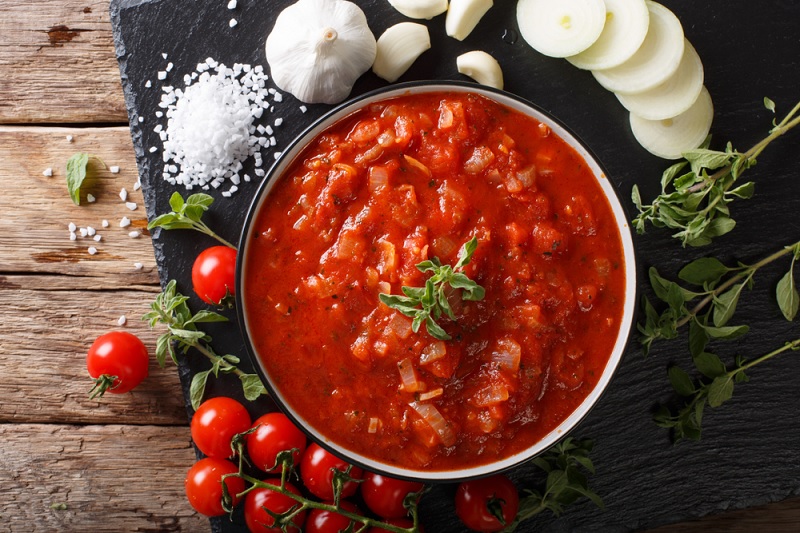One of the best ways to enjoy tomatoes is to cook them up into a delicious tomato sauce. When cooked correctly, a simple sauce can be the star of your dish and turn an otherwise bland meal into a family favourite.
The problem with homemade tomato sauce is that it often has a distinctive acidic taste. While some people may enjoy it, for many, it ruins the overall enjoyment of the dish and can cause severe indigestion.
But don’t worry! This is a common issue, and there are several easy fixes that require little extra time or effort.
Read on to learn how to make tomato sauce less acidic and why it often comes out sharp-tasting in the first place.
Can Tomato Sauce Be Made Less Acidic?
If you often find that your homemade tomato sauce has a strong acidic taste, there are a few things you can try to rectify this.
Each option is detailed below and can be used individually or in combination to achieve your desired result.
1. Change the tomatoes you’re using

Tomatoes are naturally acidic, but some varieties you can buy have a lower acid content than others. If your tomato sauce always comes out more tart than you would like, try switching the tomatoes you use and see if that makes a difference.
Generally, we recommend using fresh tomatoes when cooking, as these are the best for producing a non-acidic sauce.
Green, yellow, and orange varieties typically have a lower acid content, but some red varieties will also work well. For example, Roma tomatoes are often used in Italian cooking and are known for their sweet taste.
Tomatoes also lose acidity as they ripen, so we suggest choosing more mature ones when picking out ingredients for your sauce. There are two ways you can distinguish ripe tomatoes:
- Ripe tomatoes will feel slightly heavier than unripe ones;
- Ripe tomatoes will also be softer to the touch.
2. Reduce the tomato sauce
Increasing the sweetness of a dish is a common way of counteracting acidity.
Although this doesn’t change the level of acid, the increased sweetness will change the taste of the sauce in a way that causes us to perceive it as less sharp.
Reducing tomato sauce helps to bring out the natural sweetness.
Even just 10 minutes of extra simmering can make a massive difference to the final taste. This is because the water content of the sauce will be reduced, which thickens the sauce and amplifies all the other flavours in the pot.
If you’re short on time, add a teaspoon of sugar to your sauce for the same effect.
3. Increase the pH of the sauce
Your final option for making a tomato sauce less acidic is to increase the sauce’s pH by adding other ingredients.
The lower a food’s pH value is, the more acidic it is (see below for more details), so increasing this will help to reduce that sharp taste.
The most popular way of increasing the pH of tomato sauce is by adding a little bicarbonate of soda. This powder is naturally alkaline.
When you combine it with the acid from the tomatoes, a neutralisation reaction will occur.
During this reaction, some of the acid in the sauce is used to produce water, reducing the overall acidity of the dish.
If you don’t have any bicarbonate of soda to hand, there are other ingredients you can add to your sauce instead. Some common ones you may have around the home include:
- Butter
- Cheese
- Cream
However, it is worth noting that these will not always suit the dish you are making, so bicarbonate is usually the better choice. For example, bolognese would not be the same if you added cream.
4. Add salt

Salt is pH neutral, and adding it to tomato sauce can help mask acidity and bring out the other flavours.
It’s important not to overdo it with the salt, as this can make the sauce too salty and unpalatable.
It’s best to add a small amount of salt at a time and taste the sauce frequently until you achieve the desired flavour.
One way to reduce the perception of acidity in tomato sauce is by adding salt. Salt can help to mask the acidic taste and enhance other flavours in the sauce.
It’s important to be cautious when adding salt though, as adding too much can make it taste overly salty (as well as being bad for your health).
Add a small amount of salt and taste it. Keep adding a little more salt until it reaches the desired flavour.
This can make your tomato sauce taste less acidic and bring out the other flavours in the dish.
Why Is My Homemade Tomato Sauce So Acidic?
Whether or not a food is acidic can be determined by looking at its pH value. Generally, foods with a pH between 0 and 4.6 are considered acidic, with a lower number indicating a higher acid content.
Every time you move down a point on the pH scale, the acidity level increases tenfold. This means that foods with a pH of 3 are ten times more acidic than those with a pH of 4.
Fresh tomatoes typically have a pH of 4 to 4.6, whereas tinned tomatoes range from 3.5 to 4.7. This difference occurs because of the additives used when preserving tomatoes.
The main ingredient in tomato sauce is tomatoes, so the end result can be highly acidic due to these lower pH values.
Other popular ingredients (such as wine) can also contribute to the acidity of the sauce.

Hannah is a freelance content writer and self-proclaimed foodie. When Hannah isn’t sitting tapping at her laptop, you’ll probably find her in the kitchen. As an ex-chalet host, she’s used to cooking four-course meals for 10+ people and loves feeding friends and family whenever possible.







